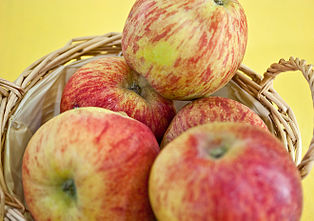Flamed cardinal
| Flamed cardinal | |
|---|---|
| Synonyms | Bischofsmütze, Falscher Gravensteiner, Pleissen summer rambour, Großer Schlotterapfel, Kaiserapfel, Strudelapfel (in Austria) |

|
|
| Art | Cultivated apple ( Malus domestica ) |
| origin | Northern Germany |
| known since | 1762 |
| ancestry | |
| List of apple varieties | |
The flamed cardinal , also flamed white cardinal , is a variety of the cultivated apple ( Malus domestica ).
Due to the long-lasting widespread distribution and the great variability of individual specimens, the apple is also known by numerous other names. Including 'Bischofsmütze', 'Rasselapfel', 'Tortenapfel', 'Bread Apple', 'Striped Pound Apple', 'Strudelapfel' and 'Falscher Gravensteiner ' as well as' Raspberry Apple ',' Himmelhahn, 'Hohlgacker' (Lake Constance), 'Hohlhäuschen' '(Pomerania),' Kaiserapfel ',' Kontorapfel '(Holstein, Hanover),' Meißner Gerstenapfel ',' Pleissener Sommerrambur '(Northern Germany),' Rasselapfel ',' Schwerer Gravensteiner ',' Semmelapfel ',' Tortenapfel '(Eifel) . In addition to the Flamed White Cardinal, there is also the 'Flamed Red Cardinal'. However, this is certainly a different variety.
description
The apple is spherical to tall, about 60 to 85 millimeters high and 70 to 90 millimeters wide. Strong edges make individual apples appear almost triangular. Often the two halves are unequal. Overall, the individual apples of this variety show unusually large differences. The loose, medium-hard to soft flesh is greenish-yellowish white. and juicy.
The skin is greenish to greenish-yellow, when it is ready for storage it can turn yellow. A red color is only weakly pronounced. Often only pale light red, it can go up to red-striped. There are individual rust spots all over the bowl . Larger rust spots can occur. The skin itself is thin, smooth and not very greasy.
The short, thick stem sits in a deep stem pit and rarely protrudes beyond it. The radiant russeting of the stem is striking.
The taste is sour-sweet and refreshing, but has hardly any flavor or smell. Apples harvested too early have a particularly sour taste.
The tree grows vigorously without intensive care, but not straight. In the youth the crown goes up, in the mature tree the tree shows a broadly arched crown and can get very old. The strong wooliness of young leaves and young shoots is striking.
history
The origin of the apple is unknown. Presumably he comes from Germany. The Flamed Cardinal was first described by the pomologist Diel in 1801. In 1860 the German Pomologists Association recommended it for cultivation. During the time of the Austro-Hungarian monarchy, the variety was recommended for cultivation in most of the crown lands. The book Our Best Fruit Varieties from 1929 , published in Wiesbaden, attests to the apple being "extremely widespread" and places it specifically in Hungary, Croatia and "in every village in Prussian Silesia ." The apple was widespread primarily as an economic and Kitchen apple, where it was used in particular to make cakes and strudels .
Cultivation
The flamed cardinal is triploid and is therefore not suitable as a pollen donor. Flowering is early in the year. The yield only sets in after a few years, but is then regular. The apple does not tend to alternate .
The flamed cardinal also thrives on poor, dry soils in unfavorable locations. The tree delivers regular yields even under unfavorable conditions. He is more sensitive to moisture and waterlogging, which can cause fruit tree cancer in him . The short-stemmed fruits tend to detach from the tree too early in strong winds, so a sheltered location is advantageous for a good harvest.
Aside from being susceptible to fruit tree cancer, the Flamed Cardinal is disease resistant.
The Flamed Cardinal is ready to be picked between mid-September and mid-October, depending on the location. It is ripe for consumption from October. In the natural camp it stays through the winter.
Remarks
- ↑ Jörg Albrecht: Tell me what the apple is called ( memento of the original from December 29, 2016 in the Internet Archive ) Info: The archive link was inserted automatically and has not yet been checked. Please check the original and archive link according to the instructions and then remove this notice. In: faz.net from October 7, 2016.
- ^ State capital Potsdam (ed.): Fruit Atlas of the Russian Colony Alexandrowka in Potsdam: A pomological guide. Potsdam 2012, p. 96.
- ↑ a b c d e f g h i j k l m n Flamed Cardinal. (PDF) Arche Noah.at, accessed on March 15, 2016 .
- ↑ a b c d e f g h Obstbaummuseum Pfaffenhofen: (70) Flamed Cardinal. In: www.obstbaummuseum.de. Retrieved March 15, 2016 .
- ↑ a b c Sort sheet Flamed Cardinal. (No longer available online.) Laimburg Research Center for Agriculture and Forestry, archived from the original on March 17, 2016 ; accessed on March 15, 2016 . Info: The archive link was inserted automatically and has not yet been checked. Please check the original and archive link according to the instructions and then remove this notice.
- ↑ a b Fruit and Horticultural Association Offenthal: Flamed Cardinal. In: www.ogv-offenthal.de. Retrieved March 15, 2016 .
- ↑ a b Our best German fruit varieties . 6th edition. 1: apples. Rud. Bechtold & Comp., Wiesbaden 1929, Flamed Cardinal ( obstsortendatenbank.de [PDF]).
- ↑ Johann Heinrich Rolff: The apple: variety names and synonyms . BoD - Books on Demand, 2001, ISBN 978-3-8311-0956-2 , pp. 140 .
